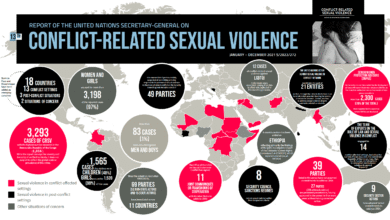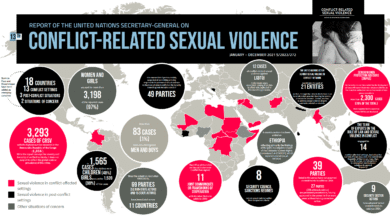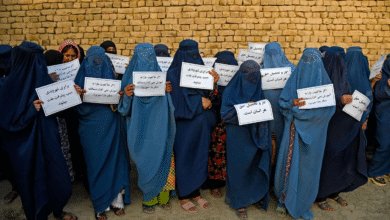Conflict-Related Sexual Violence: A Lasting Impact

Conflict-related sexual violence (CRSV) is a devastating reality of modern warfare that inflicts profound harm on individuals and communities. It is not just an unfortunate consequence of conflict; it’s a calculated tactic used to humiliate and control populations, particularly targeting women and girls. Despite the cessation of active hostilities, the trauma from sexual violence in conflict lingers, perpetuating cycles of shame and stigma. The UN’s ongoing efforts to combat this egregious form of gender-based violence highlight the urgent need for action, as recent years have seen staggering numbers of verified cases, revealing the true scale of this crisis. It is imperative for global leaders to address the impact of sexual violence, fostering a world where survivors are supported and perpetrators are held accountable.
In the aftermath of armed conflicts, sexual violence emerges as a harrowing weapon that compels admiration for the resilience of survivors. Known variously as gender-based violence or wartime sexual abuse, the implications extend far beyond the immediate physical harm, affecting social structures and community dynamics. The United Nations plays a pivotal role in raising awareness and instituting measures aimed at curtailing the prevalence of such brutality. With investigations into the gears of this violence yielding distressing statistics, it becomes increasingly clear that the fight against CRSV is essential not only for the healing of survivors but for the restoration of societal integrity. As communities grapple with the painful legacy of these actions, reframing our understanding of conflict and its consequences is crucial for fostering recovery and ensuring justice.
Understanding Conflict-Related Sexual Violence
Conflict-related sexual violence (CRSV) is not merely an act of aggression; it stands as a calculated strategy employed during conflicts, creating fear and unpredictability among marginalized populations. The historical roots of CRSV can be traced to systems of oppression, where gender-based violence is normalized as a means to control and disperse populations. The UN has recognized these acts as war crimes, underpinning the necessity for international accountability. Such acknowledgement is paramount in shifting the narrative around sexual violence in conflict from an often ignored byproduct of war to a pivotal human rights concern that demands global action.
The implications of CRSV extend far beyond individual victims, embedding psychological scars within entire communities. Survivors frequently face denial of their experiences due to prevailing stigma, leading to social ostracization and weakened community ties. Not only do these experiences perpetuate cycles of trauma among the victims, but they also destabilize communities that should otherwise function cohesively. Thus, addressing CRSV is vital for the restoration of social fabrics in post-conflict settings, reminding us that healing must occur collectively.
The Intergenerational Impact of Sexual Violence in Conflict
The consequences of conflict-related sexual violence resonate across generations, as survivors grapple with the psychological and societal repercussions of their trauma. When individuals experience such violence, it doesn’t merely affect their mental health; it often changes familial and community dynamics, leading to a cycle of trauma that is transmitted to their children. As survivors of CRSV raise children born from trauma, these children may experience a profound lack of support, facing rejection and alienation based on their backgrounds. As echoed by UN officials, addressing these intergenerational impacts is critical in ensuring that we break the cycle of violence that threatens our future.
Survivors, often left to navigate their trauma in solitude, prioritize the wellbeing of their children, yet many are incapacitated by their own pain. This dual burden, where the trauma of sexual violence intertwines with the responsibilities of parenthood, is exacerbated by social isolation and economic hardship. Without access to adequate healthcare and educational resources, children of CRSV survivors may find themselves entangled in cycles of poverty and violence, perpetuating the effects of past conflicts. The need for comprehensive support systems is critical to address these long-lasting impacts and ensure that future generations can thrive.
UN Actions on Conflict-Related Sexual Violence
The United Nations has embarked on multiple initiatives to combat conflict-related sexual violence, aiming to provide survivors with the justice and support they deserve. Policy frameworks, such as the Women, Peace, and Security Agenda, emphasize the necessity of integrating gender perspectives into peacekeeping and reconstruction efforts. These initiatives not only aim to address immediate needs but also seek to create sustainable environments where the rights and dignity of all individuals are respected. UN bodies continually advocate for comprehensive strategies, aiming to hold perpetrators accountable while ensuring survivors receive the care and support needed for recovery.
Recent UN reports highlight the necessity of international collaboration to address escalating incidences of sexual violence during conflicts. The implementation of numerous resolutions signifies a broader commitment to mitigate the impact of gender-based violence worldwide. Initiatives such as training peacekeepers to recognize and address sexual violence, building platforms for survivor testimonies, and fostering global partnerships that enhance awareness around CRSV, showcase the UN’s proactive stance. Nevertheless, overcoming the challenges posed by funding cuts and societal stigma remains critical in realizing the full potential of these actions.
Combating Gender-Based Violence in Conflict Zones
Gender-based violence, particularly during conflicts, is a critical issue that requires urgent collective action. As reports frequently indicate, women and girls are disproportionately affected by violence in conflict zones. Combatants often exploit social and gender disparities, using sexual violence as a weapon to inflict lasting harm and assert dominance. The need for targeted interventions that specifically address these gender dynamics is more crucial than ever, ensuring that strategies are not only comprehensive but also gender-sensitive, recognizing the unique experiences and needs of those affected.
Prevention of gender-based violence in conflict settings necessitates a multifaceted approach that includes strengthening local capacities for protection, legal accountability for perpetrators, and survivor-centered initiatives that empower women. Community awareness and mobilization play instrumental roles in disrupting the normalization of violence and fostering supportive environments for survivors. By investing in education and resources that highlight the importance of consent and equality, we can lay the groundwork for a more just future, one where gender-based violence has no place.
The Psychological Toll of Conflict-Related Sexual Violence
The psychological repercussions of conflict-related sexual violence (CRSV) are profound and multifaceted. Survivors often encounter not only immediate trauma but also long-term mental health issues, including post-traumatic stress disorder (PTSD), anxiety, and depression. These psychological scars frequently prevent them from reintegrating into their communities and accessing vital support services. The stigma associated with being a survivor compounds existing mental health challenges, leading many to suffer in silence, further isolating them from potential recovery.
Addressing the psychological impacts of CRSV requires a concerted effort to create safe spaces for survivors where they can access mental health support. Therapeutic interventions, community-based support groups, and awareness campaigns can play a pivotal role in normalizing these discussions and reducing stigma. Furthermore, training healthcare professionals to understand the specific needs of CRSV survivors can enhance the effectiveness of mental health services, promoting healing and resilience in affected communities. By prioritizing mental health, we not only support individual survivors but also contribute to community recovery and healing.
Community and Family Dynamics in the Wake of Sexual Violence
The devastating effects of conflict-related sexual violence ripple through communities and families, altering their dynamics irreparably. Survivors often face ostracization and shame within their own communities, leading to fractured family relations and a breakdown of social support systems. The stigma associated with sexual violence can result in survivors being labeled as ‘untouchable,’ perpetuating cycles of denial and isolation that obstruct healing. Community interventions are thus essential to rebuild trust and foster understanding among community members in order to support survivors’ reintegration.
Additionally, families of survivors are often caught in a web of trauma as they navigate the complexities of supporting loved ones who have experienced CRSV. The burden of shame and silence can lead family members to distance themselves from the survivor, compounding their feelings of isolation. Family-focused support programs can play a critical role in ensuring that these loved ones have the tools and understanding needed to provide adequate support. Through education and outreach, communities can foster environments that not only acknowledge the violence inflicted upon survivors but also honor their resilience.
The Role of Education in Healing from Conflict-Related Sexual Violence
Education serves as a cornerstone for healing and recovery for survivors of conflict-related sexual violence. It provides not only essential knowledge and skills but also a pathway towards economic independence and empowerment. Programs that enable access to education for survivors and their children can break the stigma associated with CRSV, normalize discussions around violence, and foster environments that promote healing. Furthermore, education initiatives that focus on the importance of consent and gender equality play a crucial role in preventing future violence.
Non-formal education programs that deliver trauma-informed care alongside academic learning can help survivors process their experiences in a supportive environment. Integrating psychosocial support within educational settings can address both the psychological needs and academic aspirations of survivors, creating holistic recovery pathways. By prioritizing education, we invest in the futures of survivors and contribute to building societies resilient against the cycles of violence.
The Global Response to Conflict-Related Sexual Violence
The global response to conflict-related sexual violence necessitates collaboration across borders, involving governments, NGOs, and international organizations. Advocacy efforts have expanded the conversation surrounding CRSV, making it a central theme in discussions about human rights and international law. By raising awareness and mobilizing resources, these entities work to ensure that CRSV is recognized and addressed with the urgency it demands. Global partnerships also facilitate the sharing of best practices and innovations in CRSV prevention and response.
Furthermore, the inclusion of survivor voices in the policymaking process is essential to create impactful and informed responses to conflict-related sexual violence. This participatory approach not only validates the experiences of survivors but also enhances the effectiveness of interventions by aligning them with the real needs of communities. A holistic global strategy to combat CRSV requires a commitment to collaboration, action, and a recognition of the agency of survivors in shaping their recovery and futures.
Frequently Asked Questions
What constitutes conflict-related sexual violence (CRSV)?
Conflict-related sexual violence (CRSV) refers to acts of sexual violence that occur in the context of armed conflict. These acts can include rape, sexual slavery, forced prostitution, and other forms of sexual abuse, often targeted at civilians, especially women and girls, as a method of warfare and control.
What are the impacts of sexual violence in conflict on survivors and communities?
The impacts of sexual violence in conflict are devastating. Survivors face not only physical trauma but also psychological effects, social stigma, and economic hardships. Communities suffer as social bonds break down, leading to fear and division. Survivors often struggle to reintegrate, facing isolation and poverty, which perpetuates the cycle of trauma across generations.
How does the UN address gender-based violence like CRSV in conflict zones?
The United Nations takes various actions to combat gender-based violence, including CRSV, by promoting international laws that recognize these crimes as war crimes and crimes against humanity. The UN advocates for accountability, justice for survivors, and the provision of essential support services, particularly in conflict-affected areas.
Why is it important to confront the issue of conflict-related sexual violence?
Confronting conflict-related sexual violence is crucial because it not only helps to heal the survivors but also addresses the broader societal trauma associated with such violence. Acknowledging and addressing CRSV can lead to reconciliation, rebuilding community trust, and establishing sustainable peace.
What challenges do survivors of sexual violence in conflict face when seeking justice?
Survivors of sexual violence in conflict often encounter numerous barriers to justice, including fear of retaliation, lack of access to legal support, and societal stigma. Many perpetrators remain unpunished, contributing to a culture of impunity that discourages survivors from coming forward or seeking help.
How do long-term effects of CRSV affect future generations?
The long-term effects of conflict-related sexual violence can reverberate through generations, leading to persistent trauma and societal instability. Children born from such violence often face discrimination and exclusion, perpetuating cycles of poverty and vulnerability, thereby undermining community cohesion and recovery efforts.
What can be done to prevent conflict-related sexual violence?
Preventing conflict-related sexual violence requires a multifaceted approach, including community-based interventions, education on gender-based violence, and legal reforms. Investments in women’s health and safety, as well as the establishment of safe spaces for survivors, are essential in breaking the cycle of violence and fostering recovery.
What role do community support services play in addressing CRSV?
Community support services play a critical role in addressing conflict-related sexual violence by providing essential recovery resources to survivors, such as counseling, healthcare, and legal assistance. These services empower survivors, facilitate reintegration into society, and promote awareness and prevention efforts.
What kind of support is available for survivors of sexual violence in conflict?
Survivors of sexual violence in conflict can access various support services, including medical care, psychological counseling, and legal assistance. Many organizations, including UN agencies, work to create safe spaces and provide resources to survivors to help them rebuild their lives.
How does international law define and respond to conflict-related sexual violence?
International law recognizes conflict-related sexual violence as a war crime and a crime against humanity. Responses include prosecution of offenders in international courts, such as the International Criminal Court, and the implementation of national laws to ensure accountability and protection for survivors.
| Key Point | Details |
|---|---|
| Definition of CRSV | Conflict-Related Sexual Violence (CRSV) is a tactic used in war involving sexual violence against civilians. |
| Scope of the Issue | In 2024, the UN verified approximately 4,500 cases of CRSV, though the actual numbers are likely much higher. |
| Impact on Survivors | 93% of survivors are women and girls, facing trauma, stigma, and social isolation. |
| Legal Recognition | CRSV is recognized as a war crime, a crime against humanity, and can constitute genocide. |
| Community Destruction | CRSV fragments families and communities, deepening societal divisions and undermining social cohesion. |
| Obstacles for Survivors | Survivors often face exclusion from education and employment, pushing them into poverty. |
| Justice and Redress | Many perpetrators remain unpunished due to lack of accountability and support services. |
| Need for Community Support | Community-based interventions and legislative changes are essential for prevention and survivor recovery. |
Summary
Conflict-related sexual violence has enduring consequences that extend far beyond the battlefield, impacting survivors and communities for generations. The trauma and stigma faced by victims hinder their ability to reintegrate and recover, emphasizing the urgent need for focus on prevention and support services. Recognizing the multifaceted impact of CRSV is essential for building peace and ensuring justice for victims.




